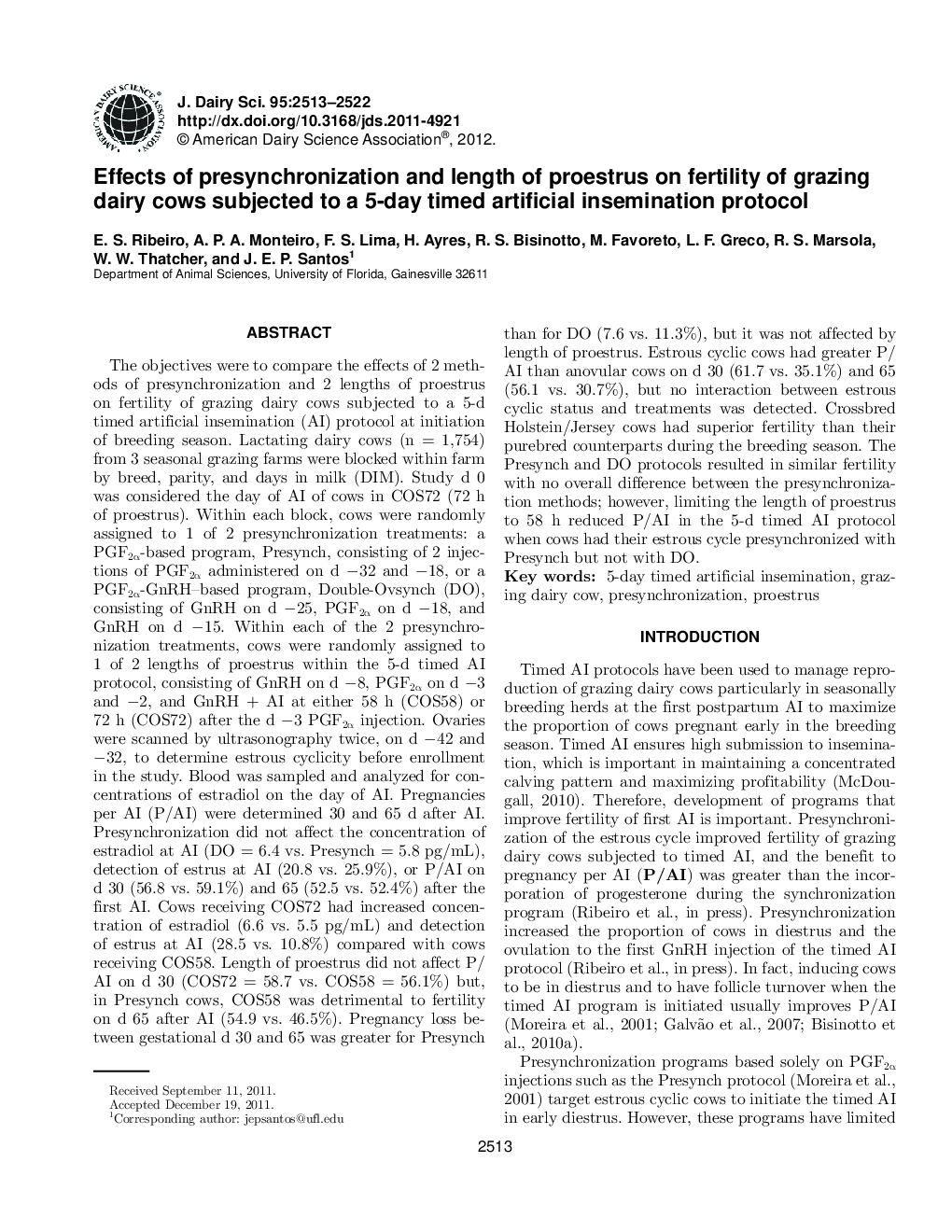| Article ID | Journal | Published Year | Pages | File Type |
|---|---|---|---|---|
| 10980219 | Journal of Dairy Science | 2012 | 10 Pages |
Abstract
The objectives were to compare the effects of 2 methods of presynchronization and 2 lengths of proestrus on fertility of grazing dairy cows subjected to a 5-d timed artificial insemination (AI) protocol at initiation of breeding season. Lactating dairy cows (n = 1,754) from 3 seasonal grazing farms were blocked within farm by breed, parity, and days in milk (DIM). Study d 0 was considered the day of AI of cows in COS72 (72 h of proestrus). Within each block, cows were randomly assigned to 1 of 2 presynchronization treatments: a PGF2α-based program, Presynch, consisting of 2 injections of PGF2α administered on d â32 and â18, or a PGF2α-GnRH-based program, Double-Ovsynch (DO), consisting of GnRH on d â25, PGF2α on d â18, and GnRH on d â15. Within each of the 2 presynchronization treatments, cows were randomly assigned to 1 of 2 lengths of proestrus within the 5-d timed AI protocol, consisting of GnRH on d â8, PGF2α on d â3 and â2, and GnRH + AI at either 58 h (COS58) or 72 h (COS72) after the d â3 PGF2α injection. Ovaries were scanned by ultrasonography twice, on d â42 and â32, to determine estrous cyclicity before enrollment in the study. Blood was sampled and analyzed for concentrations of estradiol on the day of AI. Pregnancies per AI (P/AI) were determined 30 and 65 d after AI. Presynchronization did not affect the concentration of estradiol at AI (DO = 6.4 vs. Presynch = 5.8 pg/mL), detection of estrus at AI (20.8 vs. 25.9%), or P/AI on d 30 (56.8 vs. 59.1%) and 65 (52.5 vs. 52.4%) after the first AI. Cows receiving COS72 had increased concentration of estradiol (6.6 vs. 5.5 pg/mL) and detection of estrus at AI (28.5 vs. 10.8%) compared with cows receiving COS58. Length of proestrus did not affect P/AI on d 30 (COS72 = 58.7 vs. COS58 = 56.1%) but, in Presynch cows, COS58 was detrimental to fertility on d 65 after AI (54.9 vs. 46.5%). Pregnancy loss between gestational d 30 and 65 was greater for Presynch than for DO (7.6 vs. 11.3%), but it was not affected by length of proestrus. Estrous cyclic cows had greater P/AI than anovular cows on d 30 (61.7 vs. 35.1%) and 65 (56.1 vs. 30.7%), but no interaction between estrous cyclic status and treatments was detected. Crossbred Holstein/Jersey cows had superior fertility than their purebred counterparts during the breeding season. The Presynch and DO protocols resulted in similar fertility with no overall difference between the presynchronization methods; however, limiting the length of proestrus to 58 h reduced P/AI in the 5-d timed AI protocol when cows had their estrous cycle presynchronized with Presynch but not with DO.
Related Topics
Life Sciences
Agricultural and Biological Sciences
Animal Science and Zoology
Authors
E.S. Ribeiro, A.P.A. Monteiro, F.S. Lima, H. Ayres, R.S. Bisinotto, M. Favoreto, L.F. Greco, R.S. Marsola, W.W. Thatcher, J.E.P. Santos,
